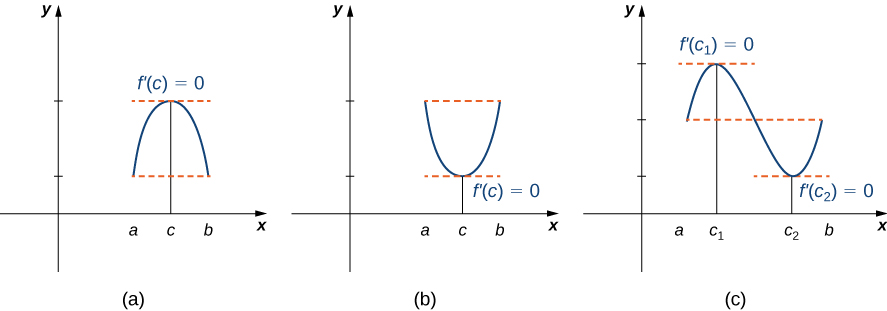
The Mean Value Theorem is one of the most important theorems in calculus. We look at some of its implications at the end of this section. First, let’s start with a special case of the Mean Value Theorem, called Rolle’s theorem.
Informally, Rolle’s theorem states that if the outputs of a differentiable function
are equal at the endpoints of an interval, then there must be an interior point
where
[link] illustrates this theorem.

Let
be a continuous function over the closed interval
and differentiable over the open interval
such that
There then exists at least one
such that
Let
We consider three cases:
for all
such that
such that
Case 1: If
for all
then
for all
Case 2: Since
is a continuous function over the closed, bounded interval
by the extreme value theorem, it has an absolute maximum. Also, since there is a point
such that
the absolute maximum is greater than
Therefore, the absolute maximum does not occur at either endpoint. As a result, the absolute maximum must occur at an interior point
Because
has a maximum at an interior point
and
is differentiable at
by Fermat’s theorem,
Case 3: The case when there exists a point
such that
is analogous to case 2, with maximum replaced by minimum.
□
An important point about Rolle’s theorem is that the differentiability of the function
is critical. If
is not differentiable, even at a single point, the result may not hold. For example, the function
is continuous over
and
but
for any
as shown in the following figure.
| = | x | −1 is not differentiable at x=0, the conditions of Rolle’s theorem are not satisfied. In fact, the conclusion does not hold here; there is no c∈(−1,1) such that f′(c)=0.”){: #CNX_Calc_Figure_04_04_002} |
Let’s now consider functions that satisfy the conditions of Rolle’s theorem and calculate explicitly the points
where
For each of the following functions, verify that the function satisfies the criteria stated in Rolle’s theorem and find all values
in the given interval where
over
over
is a polynomial, it is continuous and differentiable everywhere. In addition,
Therefore,
satisfies the criteria of Rolle’s theorem. We conclude that there exists at least one value
such that
Since
we see that
implies
as shown in the following graph.
![This function is continuous and differentiable over [−2,0], f′(c)=0 when c=−1. The function f(x) = x2 +2x is graphed. It is shown that f(0) = f(−2), and a dashed horizontal line is drawn at the absolute minimum at (−1, −1).](../resources/CNX_Calc_Figure_04_04_003.jpg)
is a polynomial and therefore is continuous and differentiable everywhere. Also,
That said,
satisfies the criteria of Rolle’s theorem. Differentiating, we find that
Therefore,
when
Both points are in the interval
and, therefore, both points satisfy the conclusion of Rolle’s theorem as shown in the following graph.
![For this polynomial over [−2,2], f′(c)=0 at x=±2/3. The function f(x) = x3 – 4x is graphed. It is obvious that f(2) = f(−2) = f(0). Dashed horizontal lines are drawn at x = ±2/square root of 3, which are the local maximum and minimum.](../resources/CNX_Calc_Figure_04_04_004.jpg)
Verify that the function
defined over the interval
satisfies the conditions of Rolle’s theorem. Find all points
guaranteed by Rolle’s theorem.
Find all values
where
Rolle’s theorem is a special case of the Mean Value Theorem. In Rolle’s theorem, we consider differentiable functions
defined on a closed interval
with
. The Mean Value Theorem generalizes Rolle’s theorem by considering functions that do not necessarily have equal value at the endpoints. Consequently, we can view the Mean Value Theorem as a slanted version of Rolle’s theorem ([link]). The Mean Value Theorem states that if
is continuous over the closed interval
and differentiable over the open interval
then there exists a point
such that the tangent line to the graph of
at
is parallel to the secant line connecting
and
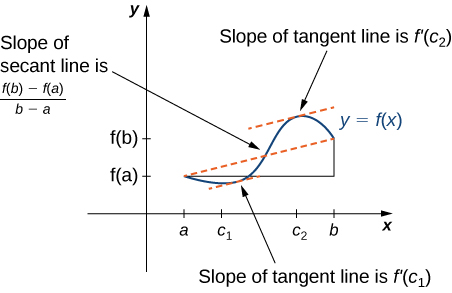
Let
be continuous over the closed interval
and differentiable over the open interval
Then, there exists at least one point
such that
The proof follows from Rolle’s theorem by introducing an appropriate function that satisfies the criteria of Rolle’s theorem. Consider the line connecting
and
Since the slope of that line is
and the line passes through the point
the equation of that line can be written as
Let
denote the vertical difference between the point
and the point
on that line. Therefore,
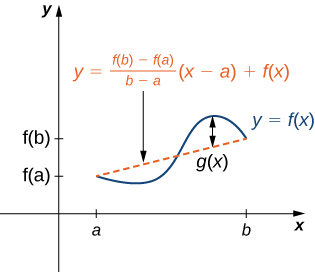
Since the graph of
intersects the secant line when
and
we see that
Since
is a differentiable function over
is also a differentiable function over
Furthermore, since
is continuous over
is also continuous over
Therefore,
satisfies the criteria of Rolle’s theorem. Consequently, there exists a point
such that
Since
we see that
Since
we conclude that
□
In the next example, we show how the Mean Value Theorem can be applied to the function
over the interval
The method is the same for other functions, although sometimes with more interesting consequences.
For
over the interval
show that
satisfies the hypothesis of the Mean Value Theorem, and therefore there exists at least one value
such that
is equal to the slope of the line connecting
and
Find these values
guaranteed by the Mean Value Theorem.
We know that
is continuous over
and differentiable over
Therefore,
satisfies the hypotheses of the Mean Value Theorem, and there must exist at least one value
such that
is equal to the slope of the line connecting
and
([link]). To determine which value(s) of
are guaranteed, first calculate the derivative of
The derivative
The slope of the line connecting
and
is given by
We want to find
such that
That is, we want to find
such that
Solving this equation for
we obtain
At this point, the slope of the tangent line equals the slope of the line joining the endpoints.
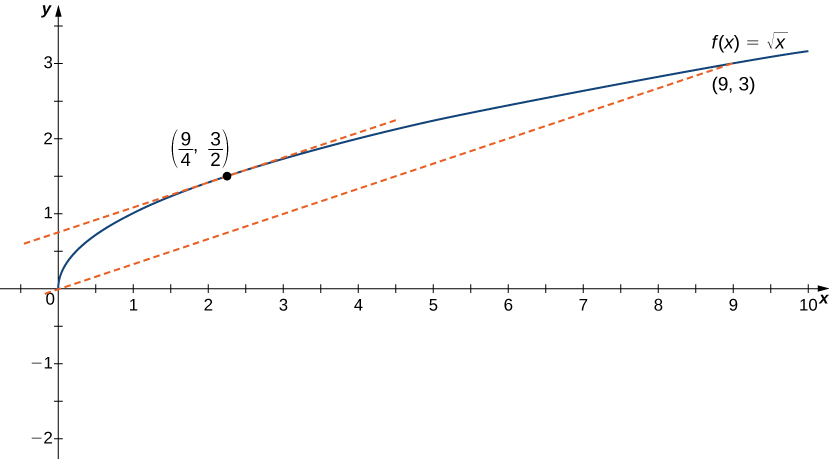
One application that helps illustrate the Mean Value Theorem involves velocity. For example, suppose we drive a car for 1 h down a straight road with an average velocity of 45 mph. Let
and
denote the position and velocity of the car, respectively, for
h. Assuming that the position function
is differentiable, we can apply the Mean Value Theorem to conclude that, at some time
the speed of the car was exactly
If a rock is dropped from a height of 100 ft, its position
seconds after it is dropped until it hits the ground is given by the function
of the rock for when the rock is released and the rock hits the ground.
guaranteed by the Mean Value Theorem when the instantaneous velocity of the rock is
Solving the equation
for
we find that
Since we are only considering
the ball will hit the ground
sec after it is dropped.
such that
Since
is continuous over the interval
and differentiable over the interval
by the Mean Value Theorem, there is guaranteed to be a point
such that
Taking the derivative of the position function
we find that
Therefore, the equation reduces to
Solving this equation for
we have
Therefore,
sec after the rock is dropped, the instantaneous velocity equals the average velocity of the rock during its free fall:
ft/sec.
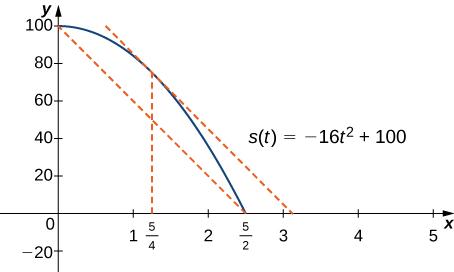
Suppose a ball is dropped from a height of 200 ft. Its position at time
is
Find the time
when the instantaneous velocity of the ball equals its average velocity.
sec
First, determine how long it takes for the ball to hit the ground. Then, find the average velocity of the ball from the time it is dropped until it hits the ground.
Let’s now look at three corollaries of the Mean Value Theorem. These results have important consequences, which we use in upcoming sections.
At this point, we know the derivative of any constant function is zero. The Mean Value Theorem allows us to conclude that the converse is also true. In particular, if
for all
in some interval
then
is constant over that interval. This result may seem intuitively obvious, but it has important implications that are not obvious, and we discuss them shortly.
Let
be differentiable over an interval
If
for all
then
constant for all
Since
is differentiable over
must be continuous over
Suppose
is not constant for all
in
Then there exist
where
and
Choose the notation so that
Therefore,
Since
is a differentiable function, by the Mean Value Theorem, there exists
such that
Therefore, there exists
such that
which contradicts the assumption that
for all
□
From [link], it follows that if two functions have the same derivative, they differ by, at most, a constant.
If
and
are differentiable over an interval
and
for all
then
for some constant
Let
Then,
for all
By Corollary 1, there is a constant
such that
for all
Therefore,
for all
□
The third corollary of the Mean Value Theorem discusses when a function is increasing and when it is decreasing. Recall that a function
is increasing over
if
whenever
whereas
is decreasing over
if
whenever
Using the Mean Value Theorem, we can show that if the derivative of a function is positive, then the function is increasing; if the derivative is negative, then the function is decreasing ([link]). We make use of this fact in the next section, where we show how to use the derivative of a function to locate local maximum and minimum values of the function, and how to determine the shape of the graph.
This fact is important because it means that for a given function
if there exists a function
such that
then, the only other functions that have a derivative equal to
are
for some constant
We discuss this result in more detail later in the chapter.

Let
be continuous over the closed interval
and differentiable over the open interval
for all
then
is an increasing function over
for all
then
is a decreasing function over
We will prove i.; the proof of ii. is similar. Suppose
is not an increasing function on
Then there exist
and
in
such that
but
Since
is a differentiable function over
by the Mean Value Theorem there exists
such that
Since
we know that
Also,
tells us that
We conclude that
However,
for all
This is a contradiction, and therefore
must be an increasing function over
□
is continuous over
and differentiable over
and
then there exists a point
such that
This is Rolle’s theorem.
is continuous over
and differentiable over
then there exists a point
such that
This is the Mean Value Theorem.
over an interval
then
is constant over
and
satisfy
over
then
for some constant
over an interval
then
is increasing over
If
over
then
is decreasing over
Why do you need continuity to apply the Mean Value Theorem? Construct a counterexample.
Why do you need differentiability to apply the Mean Value Theorem? Find a counterexample.
One example is
When are Rolle’s theorem and the Mean Value Theorem equivalent?
If you have a function with a discontinuity, is it still possible to have
Draw such an example or prove why not.
Yes, but the Mean Value Theorem still does not apply
For the following exercises, determine over what intervals (if any) the Mean Value Theorem applies. Justify your answer.
For the following exercises, graph the functions on a calculator and draw the secant line that connects the endpoints. Estimate the number of points
such that
[T]
over
2 points
[T]
over
[T]
over
5 points
[T]
over
For the following exercises, use the Mean Value Theorem and find all points
such that
For the following exercises, show there is no
such that
Explain why the Mean Value Theorem does not apply over the interval
Not differentiable
Not differentiable
(Hint: This is called the floor function and it is defined so that
is the largest integer less than or equal to
For the following exercises, determine whether the Mean Value Theorem applies for the functions over the given interval
Justify your answer.
over
Yes
over
over
The Mean Value Theorem does not apply since the function is discontinuous at
over
over
Yes
over
over
The Mean Value Theorem does not apply; discontinuous at
over
over
Yes
over
over
The Mean Value Theorem does not apply; not differentiable at
For the following exercises, consider the roots of the equation.
Show that the equation
has exactly one real root. What is it?
Find the conditions for exactly one root (double root) for the equation
Find the conditions for
to have one root. Is it possible to have more than one root?
For the following exercises, use a calculator to graph the function over the interval
and graph the secant line from
to
Use the calculator to estimate all values of
as guaranteed by the Mean Value Theorem. Then, find the exact value of
if possible, or write the final equation and use a calculator to estimate to four digits.
[T]
over
[T]
over
[T]
over
The Mean Value Theorem does not apply.
[T]
over
[T]
over
At 10:17 a.m., you pass a police car at 55 mph that is stopped on the freeway. You pass a second police car at 55 mph at 10:53 a.m., which is located 39 mi from the first police car. If the speed limit is 60 mph, can the police cite you for speeding?
Two cars drive from one spotlight to the next, leaving at the same time and arriving at the same time. Is there ever a time when they are going the same speed? Prove or disprove.
Yes
Show that
and
have the same derivative. What can you say about
Show that
and
have the same derivative. What can you say about
It is constant.
is continuous over
and differentiable over
then there exists
such that
is continuous over
and differentiable over
and if
then there exists
such that

You can also download for free at http://cnx.org/contents/9a1df55a-b167-4736-b5ad-15d996704270@5.1
Attribution: